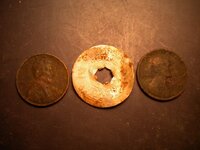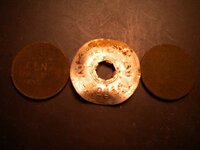Dirt fishing Wolf
Bronze Member
- Dec 29, 2009
- 2,198
- 420
- Detector(s) used
- DFX, Nokta Makro Simplex +
- Primary Interest:
- All Treasure Hunting
Got out for a couple of hours today. Found 2 wheaties and a Colorado Sales Tax Retail Token.
The token reads the same front and back with a 2 on each side of the hole. Does any one
know if this would stand for 1922, 2cents or 22 cents? First picture is this site from years
past and what it looked like today. Front steps match. HH DFW

The token reads the same front and back with a 2 on each side of the hole. Does any one
know if this would stand for 1922, 2cents or 22 cents? First picture is this site from years
past and what it looked like today. Front steps match. HH DFW









